tow Lancia Delta 2012 Owner handbook (in English)
[x] Cancel search | Manufacturer: LANCIA, Model Year: 2012, Model line: Delta, Model: Lancia Delta 2012Pages: 295, PDF Size: 8.29 MB
Page 95 of 295

1
KNOWING YOUR CAR93
Electric window system initialisation
The system must be re-initialised after disconnecting the
battery or if the relevant protection fuse is blown.
Initialisation procedure:
❍fully close the window to be initialised manually;
❍once fully closed, keep holding down the closing con-
trol for at least 1 second.
IMPORTANT Where provided, after there has been no
power supply for the control units (battery replaced or
disconnected or protective fuses for the electric window
control units replaced), the automatic operation of the
windows must be restored.The restoration procedure must be performed as follows
with the doors closed:
1. completely open the driver’s door window keeping the
operating button pressed for at least three seconds af-
ter the (lower) end of travel position;
2. completely raise the driver’s side window and keep the
button pressed for at least three seconds once the end
of travel position (upper end stop) has been reached;
3. repeat stages 1 and 2 for the passenger-side window
4. make sure that the initialisation is correct by check-
ing that the windows work automatically.
IMPORTANT With central locking on, operating the in-
ternal handle of one of the doors will unlock all the doors.
If there is no electric power supply (fuse blown, battery
disconnected, etc.) it is still possible to operate the door
locking manually; in this case the automatic lowering
function for the windows is not available and to open or
close the door with the window closed it is necessary to
exert pressure on the window towards the inside of the
vehicle to facilitate the movement of the window on the
moulding.
Page 105 of 295

1
KNOWING YOUR CAR103
HEADLIGHTS
HEADLIGHT BEAM AIMING
The correct aiming of the headlights is important for the
comfort and safety of not only the driver but all other
road users. This is also covered by a specific rule of the
highway code.
The headlights must be correctly aimed to guarantee the
best visibility conditions for all drivers while travelling
with headlights on.
Contact a Lancia Dealership to have the headlights prop-
erly adjusted.
Check beam alignment every time the load or its distri-
bution changes.
ANGLE COMPENSATION fig. 64
The car is fitted with an electric headlight alignment sys-
tem. This system is operational with the ignition key
turned to MAR and the dipped beam headlights on.
When the car is loaded, it slopes backwards. This means
the headlight beam rises.
In this case, it is necessary to adjust the beams using but-
tons A and B.
The display provides a visual indication of the positions
during adjustment.Correct positions depending on the load
Position 0 – one or two people in the front seats.
Position 1 – five passengers.
Position 2 – five people + load in the boot.
Position 3 – driver + maximum permitted load stowed
in the luggage compartment.
FRONT FOG LIGHTS ALIGNMENT
(for versions/markets where provided)
Contact a Lancia Dealership to have the lights properly
adjusted.
fig. 64L0E0054m
Page 136 of 295
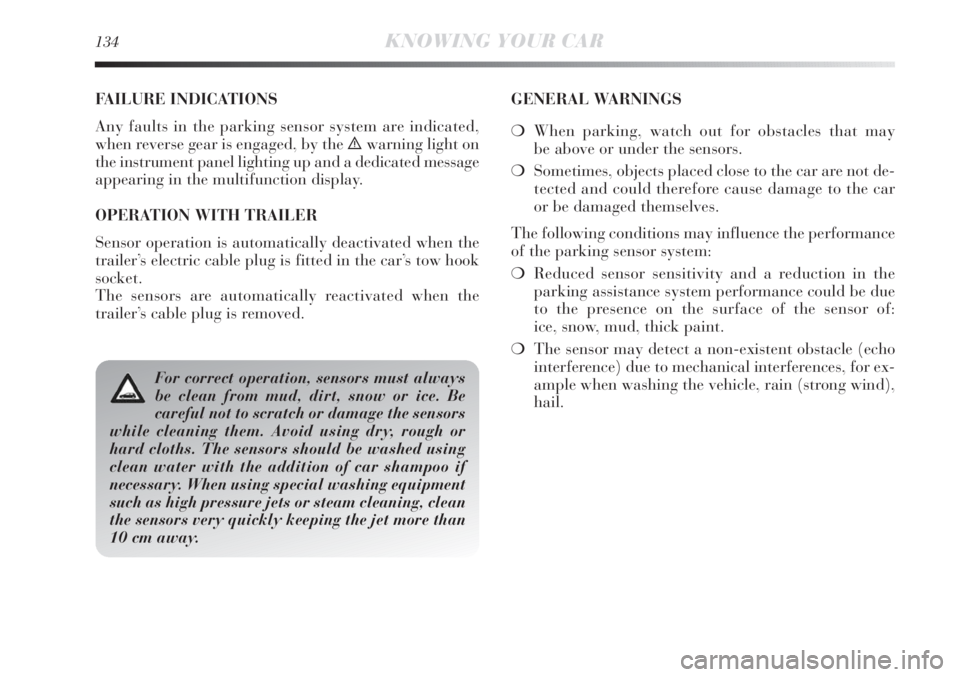
134KNOWING YOUR CAR
FAILURE INDICATIONS
Any faults in the parking sensor system are indicated,
when reverse gear is engaged, by the
èwarning light on
the instrument panel lighting up and a dedicated message
appearing in the multifunction display.
OPERATION WITH TRAILER
Sensor operation is automatically deactivated when the
trailer’s electric cable plug is fitted in the car’s tow hook
socket.
The sensors are automatically reactivated when the
trailer’s cable plug is removed.
For correct operation, sensors must always
be clean from mud, dirt, snow or ice. Be
careful not to scratch or damage the sensors
while cleaning them. Avoid using dry, rough or
hard cloths. The sensors should be washed using
clean water with the addition of car shampoo if
necessary. When using special washing equipment
such as high pressure jets or steam cleaning, clean
the sensors very quickly keeping the jet more than
10 cm away.
GENERAL WARNINGS
❍When parking, watch out for obstacles that may
be above or under the sensors.
❍Sometimes, objects placed close to the car are not de-
tected and could therefore cause damage to the car
or be damaged themselves.
The following conditions may influence the performance
of the parking sensor system:
❍Reduced sensor sensitivity and a reduction in the
parking assistance system performance could be due
to the presence on the surface of the sensor of:
ice, snow, mud, thick paint.
❍The sensor may detect a non-existent obstacle (echo
interference) due to mechanical interferences, for ex-
ample when washing the vehicle, rain (strong wind),
hail.
Page 142 of 295

140KNOWING YOUR CAR
❍parking space longer than 130 cm compared to the
vehicle dimensions:parking in more than one manoeu-
vre, where only the first one can be carried out by auto-
matic steering management (the subsequent manoeuvres
are entirely the responsibility of the driver).
To select the search and manoeuvring side, the driver
must:
1)
DChoose to carry out the search for the space and the
manoeuvre on the passenger side with:
❍the direction indicator in the middle position;
❍the hazard warning lights on;
❍the hazard warning lights on and the direction indi-
cator in the passenger side position;
❍the direction indicator pointing towards the passen-
ger side.
2)
FChoose to carry out the search for the space and the
manoeuvre on the driver’s side with:
❍the direction indicator in the driver’s side position;
❍the hazard warning lights on and the direction indi-
cator in the driver side position;
The system will notify the driver, on the side in which the
search and the manoeuvre are taking place by means of
dedicated messages in the instrument panel display and
the symbol (
Fand
D) different on the right and left sides. The search will, however, take place on both sides, there-
fore it is possible to make the selection using the direc-
tion indicators even when having just driven past a park-
ing space that is deemed suitable.
During the search step, speed should not exceed 30 km/h;
when 25 km/h have been reached, the driver is asked to
decrease the speed; if the speed of 30 km/h is exceeded,
the system is disabled; in this case, the system must be
restarted by pressing the button A-fig. 82.
If the Lane crossing function is activated (see “Exterior
lights” paragraph) the search for the parking space al-
ways takes place on the passenger side.
If the parking sensors are activated during the search for
a parking space (see “Front and rear parking sensors”
paragraph), the operation of the Magic Parking system is
deactivated.
The search for the parking space and the
parking manoeuvres must be made in com-
pliance with the regulations in force of the
Highway Code.
Page 151 of 295
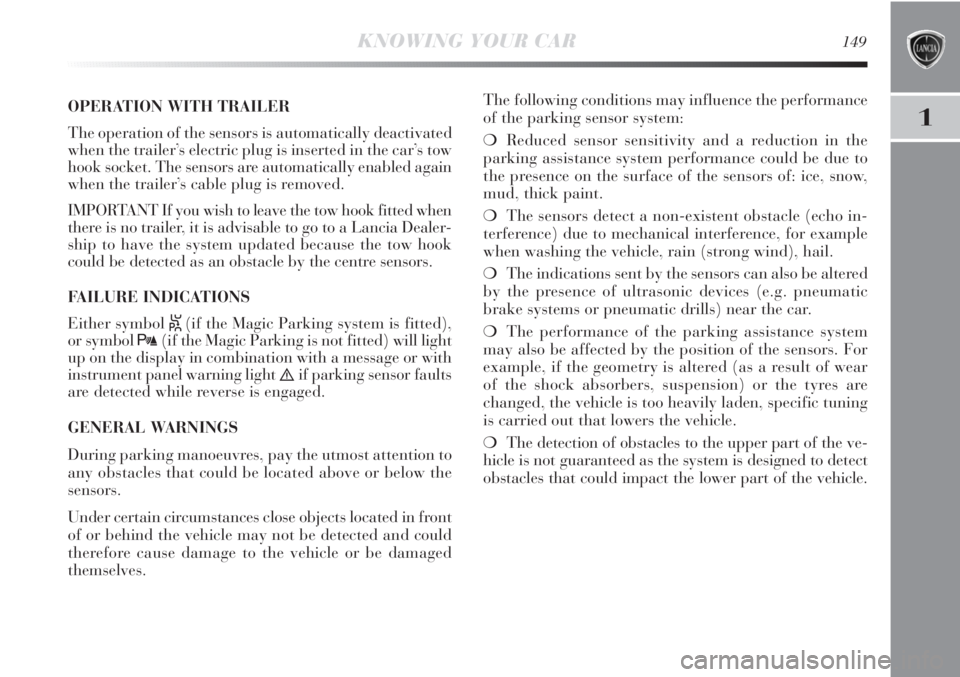
1
KNOWING YOUR CAR149
OPERATION WITH TRAILER
The operation of the sensors is automatically deactivated
when the trailer’s electric plug is inserted in the car’s tow
hook socket. The sensors are automatically enabled again
when the trailer’s cable plug is removed.
IMPORTANT If you wish to leave the tow hook fitted when
there is no trailer, it is advisable to go to a Lancia Dealer-
ship to have the system updated because the tow hook
could be detected as an obstacle by the centre sensors.
FAILURE INDICATIONS
Either symbol
S(if the Magic Parking system is fitted),
or symbol
t(if the Magic Parking is not fitted) will light
up on the display in combination with a message or with
instrument panel warning light
èif parking sensor faults
are detected while reverse is engaged.
GENERAL WARNINGS
During parking manoeuvres, pay the utmost attention to
any obstacles that could be located above or below the
sensors.
Under certain circumstances close objects located in front
of or behind the vehicle may not be detected and could
therefore cause damage to the vehicle or be damaged
themselves.The following conditions may influence the performance
of the parking sensor system:
❍Reduced sensor sensitivity and a reduction in the
parking assistance system performance could be due to
the presence on the surface of the sensors of: ice, snow,
mud, thick paint.
❍The sensors detect a non-existent obstacle (echo in-
terference) due to mechanical interference, for example
when washing the vehicle, rain (strong wind), hail.
❍The indications sent by the sensors can also be altered
by the presence of ultrasonic devices (e.g. pneumatic
brake systems or pneumatic drills) near the car.
❍The performance of the parking assistance system
may also be affected by the position of the sensors. For
example, if the geometry is altered (as a result of wear
of the shock absorbers, suspension) or the tyres are
changed, the vehicle is too heavily laden, specific tuning
is carried out that lowers the vehicle.
❍The detection of obstacles to the upper part of the ve-
hicle is not guaranteed as the system is designed to detect
obstacles that could impact the lower part of the vehicle.
Page 179 of 295
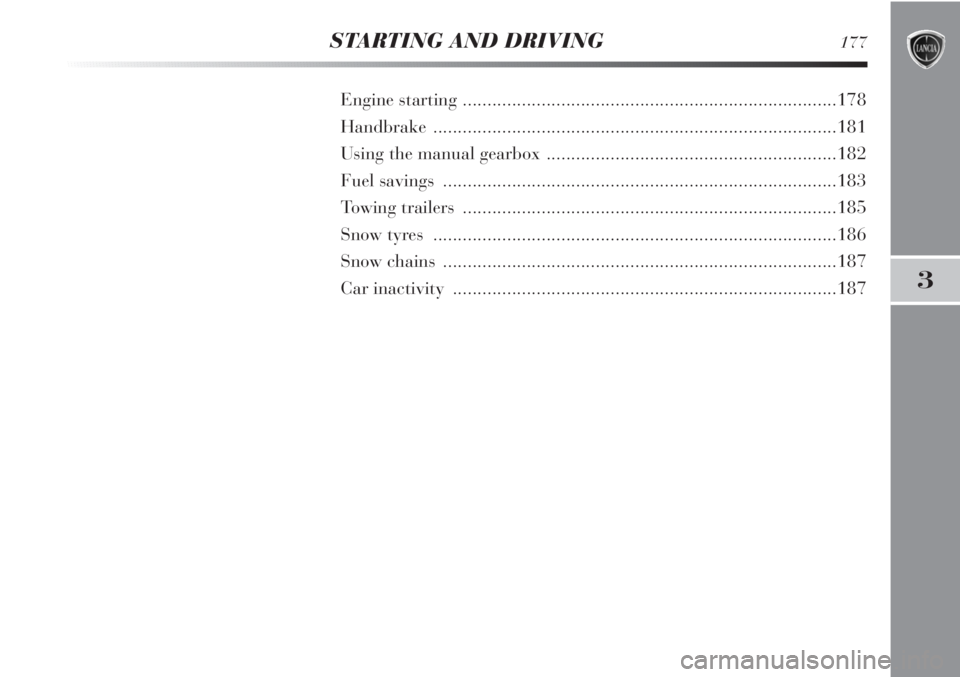
STARTING AND DRIVING177
3
Engine starting ............................................................................178
Handbrake ..................................................................................181
Using the manual gearbox ...........................................................182
Fuel savings ................................................................................183
Towing trailers ............................................................................185
Snow tyres ..................................................................................186
Snow chains ................................................................................187
Car inactivity ..............................................................................187
Page 182 of 295

180STARTING AND DRIVING
Never bump start the engine by pushing,
towing or coasting downhill. This could
cause a flow of fuel into the catalytic con-
verter and damage it beyond repair.
HOW TO WARM UP THE ENGINE
AFTER IT HAS JUST STARTED
Proceed as follows:
❍drive off slowly, letting the engine turn at medium
speed. Do not accelerate abruptly;
❍do not demand maximum performance for the first
few kilometres. Wait until the engine coolant gauge
starts moving.STOPPING THE ENGINE
Turn the ignition key to STOP while the engine is idling.
IMPORTANT After a taxing drive, you should allow the
engine to “catch its breath” before turning it off by let-
ting it idle to allow the temperature in the engine com-
partment to fall.
A quick burst on the accelerator before turn-
ing off the engine serves absolutely no prac-
tical purpose, it wastes fuel and is damag-
ing especially to turbocharged engines.
Page 185 of 295
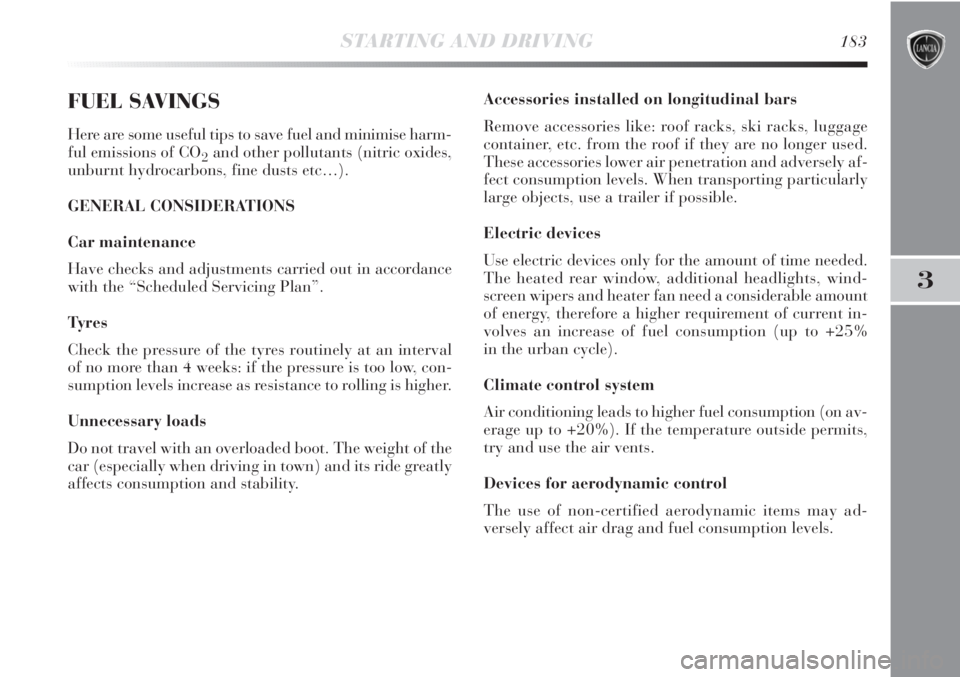
3
STARTING AND DRIVING183
FUEL SAVINGS
Here are some useful tips to save fuel and minimise harm-
ful emissions of CO
2and other pollutants (nitric oxides,
unburnt hydrocarbons, fine dusts etc…).
GENERAL CONSIDERATIONS
Car maintenance
Have checks and adjustments carried out in accordance
with the “Scheduled Servicing Plan”.
Ty r e s
Check the pressure of the tyres routinely at an interval
of no more than 4 weeks: if the pressure is too low, con-
sumption levels increase as resistance to rolling is higher.
Unnecessary loads
Do not travel with an overloaded boot. The weight of the
car (especially when driving in town) and its ride greatly
affects consumption and stability.Accessories installed on longitudinal bars
Remove accessories like: roof racks, ski racks, luggage
container, etc. from the roof if they are no longer used.
These accessories lower air penetration and adversely af-
fect consumption levels. When transporting particularly
large objects, use a trailer if possible.
Electric devices
Use electric devices only for the amount of time needed.
The heated rear window, additional headlights, wind-
screen wipers and heater fan need a considerable amount
of energy, therefore a higher requirement of current in-
volves an increase of fuel consumption (up to +25%
in the urban cycle).
Climate control system
Air conditioning leads to higher fuel consumption (on av-
erage up to +20%). If the temperature outside permits,
try and use the air vents.
Devices for aerodynamic control
The use of non-certified aerodynamic items may ad-
versely affect air drag and fuel consumption levels.
Page 186 of 295

184STARTING AND DRIVING
DRIVING STYLE
Starting
Do not warm the engine with the car at a standstill or at
idle or high speed: under these conditions the engine
warms up much more slowly, increasing electrical con-
sumption and emissions. It is therefore advisable to move
off immediately, slowly, avoiding high speeds: in this way
the engine will warm faster.
Unnecessary actions
Avoid revving up when at traffic lights or before stopping
the engine. The latter action, like double-declutching, is
completely unnecessary and causes increased fuel con-
sumption and pollution.
Gear selection
As soon as the conditions of the traffic and road allow,
use a higher gear. Using a low gear for faster acceleration
will increase consumption.
In the same way improper use of a high gear increases
consumption, emissions and engine wear.
Max. speed
Fuel consumption considerably increases with speed.
Avoiding unnecessary braking and acceleration, which
cost in terms of both fuel and emissions.Acceleration
Accelerating violently will greatly affect consumption and
emissions: acceleration should be gradual.
CONDITIONS OF USE
Cold starting
Short journeys and frequent cold starts do not allow the
engine to reach optimum operating temperature. This re-
sults in a significant increase in consumption levels (from
+15 to +30% on the urban cycle) and emissions.
Traffic and road conditions
Rather high fuel consumption is caused by heavy traf-
fic, for instance when travelling in a queue with frequent
use of low gears or in large towns with many traffic lights.
Mountain and rough roads also have a negative effect on
fuel consumption.
Traffic hold-ups
During prolonged hold-ups (e.g. level crossings) the en-
gine should be switched off.
Page 187 of 295
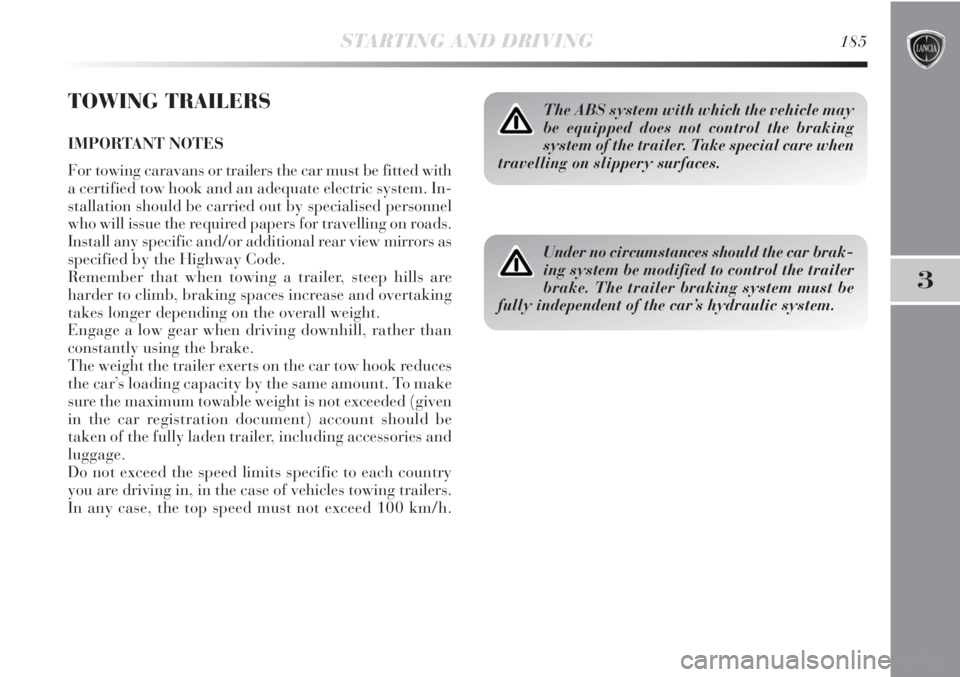
3
STARTING AND DRIVING185
TOWING TRAILERS
IMPORTANT NOTES
For towing caravans or trailers the car must be fitted with
a certified tow hook and an adequate electric system. In-
stallation should be carried out by specialised personnel
who will issue the required papers for travelling on roads.
Install any specific and/or additional rear view mirrors as
specified by the Highway Code.
Remember that when towing a trailer, steep hills are
harder to climb, braking spaces increase and overtaking
takes longer depending on the overall weight.
Engage a low gear when driving downhill, rather than
constantly using the brake.
The weight the trailer exerts on the car tow hook reduces
the car’s loading capacity by the same amount. To make
sure the maximum towable weight is not exceeded (given
in the car registration document) account should be
taken of the fully laden trailer, including accessories and
luggage.
Do not exceed the speed limits specific to each country
you are driving in, in the case of vehicles towing trailers.
In any case, the top speed must not exceed 100 km/h.
The ABS system with which the vehicle may
be equipped does not control the braking
system of the trailer. Take special care when
travelling on slippery surfaces.
Under no circumstances should the car brak-
ing system be modified to control the trailer
brake. The trailer braking system must be
fully independent of the car’s hydraulic system.